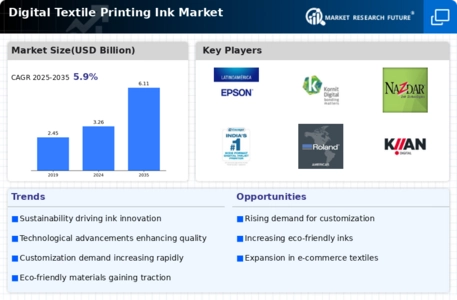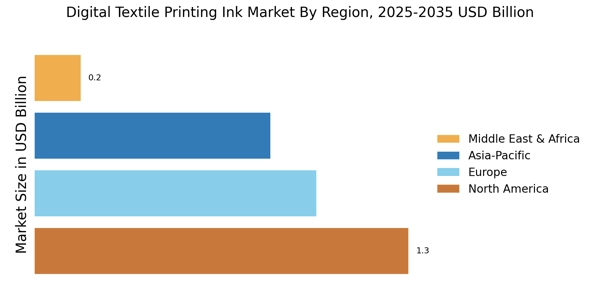The Digital Textile Printing Ink Market is currently characterized by a dynamic competitive landscape, driven by technological advancements and increasing demand for customized textile solutions. Key players such as Epson (Japan), Kornit Digital (Israel), and Avery Dennison (US) are strategically positioning themselves through innovation and regional expansion. Epson (Japan) focuses on enhancing its product offerings with eco-friendly inks, while Kornit Digital (Israel) emphasizes its direct-to-garment printing technology, which caters to the growing trend of on-demand production. Avery Dennison (US) is leveraging partnerships to expand its market reach, particularly in sustainable textile solutions, thereby shaping a competitive environment that prioritizes innovation and sustainability.
In terms of business tactics, companies are increasingly localizing manufacturing to reduce lead times and optimize supply chains. The market structure appears moderately fragmented, with several players vying for market share. However, the collective influence of major companies like Durst (Italy) and Brother Industries (Japan) is notable, as they contribute to a competitive atmosphere that encourages continuous improvement and technological advancements.
In August 2025, Epson (Japan) announced the launch of its new line of water-based inks designed for high-speed digital textile printing. This strategic move is significant as it aligns with the growing demand for sustainable printing solutions, potentially enhancing Epson's market share in eco-conscious segments. The introduction of these inks may also bolster the company's reputation as a leader in environmentally friendly technologies.
In September 2025, Kornit Digital (Israel) unveiled a new software platform aimed at streamlining the production process for digital textile printing. This initiative is crucial as it not only enhances operational efficiency but also positions Kornit as a frontrunner in integrating technology with textile printing, catering to the increasing need for automation in manufacturing processes. The software's capabilities could significantly reduce turnaround times, appealing to brands seeking agility in their supply chains.
In July 2025, Avery Dennison (US) entered a strategic partnership with a leading fashion retailer to develop a line of sustainable textile labels. This collaboration underscores the importance of sustainability in the current market and reflects Avery Dennison's commitment to innovation in textile solutions. By aligning with a prominent retailer, the company is likely to enhance its visibility and credibility in the sustainable textiles sector, potentially driving further growth.
As of October 2025, the Digital Textile Printing Ink Market is witnessing trends such as digitalization, sustainability, and the integration of artificial intelligence. Strategic alliances among key players are increasingly shaping the competitive landscape, fostering innovation and collaboration. Moving forward, it appears that competitive differentiation will evolve from traditional price-based strategies to a focus on technological innovation, sustainability, and supply chain reliability, indicating a shift towards a more sophisticated and value-driven market.


















Leave a Comment